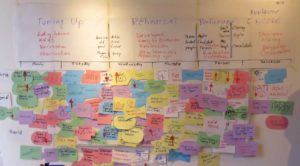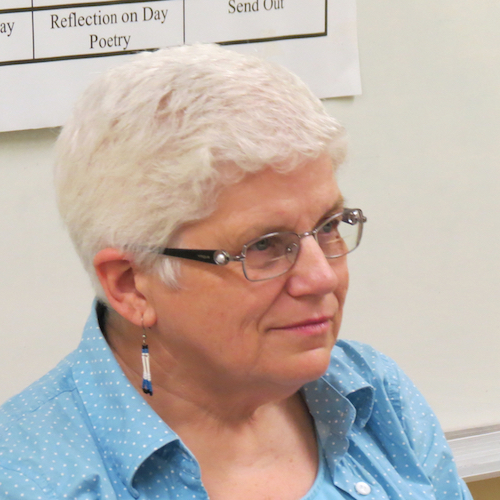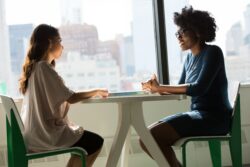As facilitators, when we work with groups, we can help our clients appreciate their past to give them a comprehensive sense of the present and the ability to project where the future might go. The Journey Wall, or Historical Scan, is a great way for a diverse group to acknowledge everything that has happened.

The ToP Journey Wall process was created by ICA in the 1970’s. Because it reveals much more than any one individual is able to recall or integrate, it has been referred to as a “Wall of Wonder.” It has also been referred to as an “Historical Scan”. It has been used for:
- Creating a context for strategic planning
- Reviewing project implementation
- Regular review of an organization’s work
- Project evaluation
- Analyzing historical trends
- Personal reflection
The Underlying Method: the ToP™ Focused Conversation Method
The Journey Wall is based on a fundamental method of ICA, the structure of the Focused Conversation Method. This four-step method is the single most powerful method in any facilitator’s toolkit. The basic structure is:
Objective – concrete, observable data — recalling events
Reflective – internal reactions, associations and images — key events, high and low points
Interpretive- underlying meaning, story, significance — identifying turning points and major phases
Decisional- resolution — naming the sections and the whole, pulling together the story
10 Steps in the Process
Preparation: Before beginning, decide the timeframe and prepare a horizontal timeline on the wall — draw a line about 1/3 of the distance down, and divide into time blocks. (See page 11 for a sample.) The timeframe needs to fit the situation and the needs of the group. It is usually a period that covers the history of the group. You will need 8 – 10 feet of wall space, or an equivalent amount of an online whiteboard.
- Opening: Welcome the participants and set the context for the session; including the purpose, how this fits into the life of the group, why it is important, and a very brief description of the major steps in the process.
- Individual Brainstorm: Ask each person to jot down 10 or more events that they think have been significant for the group. Ask for actual events that happened rather than thoughts that the events triggered. They may be positive, neutral or negative. These may be global, regional or local events or another categories that capture important levels of what is going on.
- Small Group Brainstorm: Divide the group into small teams of people that do not normally work together. Ask them to go around the group and share their lists one event at a time. They eliminate the overlap and generate a common list of events. Each event should be written or drawn on an 5×8 card in large letters with the date of the event noted, or on stickies for an online whiteboard.
- Arrange Cards on the Timeline: Call the whole group together and ask them to pass up their cards from the earliest time block. Read the items and stick them on the timeline in the appropriate space. Repeat this for each time block until all of the cards are on the wall. Duplicates may be placed on top of each other. When they are all up, ask if there are any others that may have been missed.
- Reflect on the Timeline: Ask the group which items stand out for them or were surprises, which ones are key events for the group, which ones are high or low points. High and low points can be marked to make them stand out. Ask about fast or slow periods. Ask about connections that they see among the events. You may want to draw a “mood line” to indicate the morale level.
- Discern the Turning Points: Ask the group to find the key turning points. Allow for some discussion to allow the group to form a common mind about the key shifts. Make vertical lines above the timeline to indicate these points. This will reveal 3 – 5 major sections of the timeline.
- Name Sections of the Journey: Ask the group to name each section. Work, one section at a time, from the earliest section to the most recent. Get several suggestions for each section until the group settles on a name for the section. People may use metaphors that have special meaning for the group. Finally, ask for a title for the whole timeline that describes the group’s experience.
- Create the Story: Ask several people to tell a story about the timeline. It may be set as a fairy tale, an epic drama or like a movie. Rename or add names to the sections or the whole if necessary to represent the emerging story.
- Discuss the Group’s Insights: Ask the group what insights came to them as they went through the process. Depending on the situation, it may be helpful to focus on practial things that they have learned, emerging trends and directions or implications for the future.
- Closing: Discuss what the group will do with the work done. It may be photographed, documented on a computer and distributed, put up as it is in a public place or given an artistic rendition. Make assignments and any necessary announcements.
Additional Hints for Success:
Participants of an Journey Wall use several types of thinking and engage in many different processes during the exercise. The following points illustrate the typical dialogue which occurs during the Journey Wall and will give you reference points when using the method.
A timeline on the wall is the visual device
A “timeline” on the wall is the main visual device of the Journey Wall. The timeline could be a 10 foot piece of tape running horizontally across a wall, or a chalk line drawn across a blackboard with short vertical bars marking off the years. The “timeline” could go back 5 years for some new organizations or 50 to 100 years for an established community. The timeline can project forward a year or two, but in some cases up to 5 years. In western culture, because of our left to right reading style, people generally view the left end as the past and the right end as the present or future.
Actual events and dates are the raw material
It is important at the beginning of the Journey Wall to focus participants on brainstorming actual events. Encourage them to write down happenings that occured at a spot in time. The event may have happened to an individual or be known to the whole group. By remembering and objectifying actual events that have occured, people can “experience their experience.”
Some participants might need an explanation on the difference between an event and an idea. “Management changed in 1985 when two directors retired” is an example of an actual event. “In 1985 I learned that leadership is crucial” is not an event.
The focus on events allows a group to see the ‘flow’ of past events, and helps them “learn their learnings.” For instance there could be significantly more learning from reflecting on a series of big sales over the year, than by simply looking at a consolidated income and expense sheet.
There are no “good” or “bad” events. Just reality.
All events are relevant and can be written on the timeline without judgement. There is as much to be gained from a painful experience as from a happy one. “The temporary plant shutdown in 1991” can be just as important as the “new product announcement in 1993.” Acknowledging all events can be vital to learning from the Journey Wall. “The big strike in 1995” might seem like a negative event to put on a timeline, but it might well be the one key learning point from several different perspectives.
Seemingly unrelated events give the “big picture”
Creating a horizontal row of world events, a row of events at an intermediate level (such as “the region” or “the field”), and a major focus on the local level (“this organization” or “the community”) makes it possible to see how events in the larger world have had an impact on the local level and vice versa. The eruption of Mount Saint Hélène could disrupt economic patterns in an organization thousands of miles away. The Gulf War could preoccupy employees of an organization with no seeming causal link at all. In the same way, personal events like the birth or death of a family member can dramatically alter one’s perception.
Differing viewpoints are valuable
Any event on a timeline might be a “high point” for one individual and a “low point” for another. “It was terrible for me when we moved the office in 1991.” says one. “Being on the moving committee was the best time of my career.” says another. People are amazed when they realize they are oblivious to other people’s needs. Allowing participants to talk about their perspectives on events can be very important. Sometimes healing can occur between individuals who have been at odds.
Historical “turning points” are central
Some events are powerful indicators of a turning point for the organization. The “loss of a government grant in 1986” might be the turning point in a move towards greater independence. “The flood of 1993” might be a turning point for a community working together for the first time. During an Journey Wall, something considered a tragedy or low point can suddenly be recognized as a turning point. Several high points or low points in the same period could be an indicator of a real turning point. There will often be two or three turning points discovered in an Journey Wall.
The story of the journey can use metaphors
When participants discuss the flow of an organization’s history and its turning points, they sometimes use the language of metaphors. “For these three years we took baby steps. We walked slowly for these next five years. Now we are taking giant strides.” “Ship at Sea without a Rudder; Steady Course Ahead; Land in Sight” might describe the group’s experience over a ten year period. You can help people access metaphors by asking them what the periods remind them of; movies, fairy tales, animals, etc. Helping participants name the periods of their history in metaphors can change fate to a meaningful destiny.
Creative visuals can be fun
The timeline on the wall, and the use of coloured paper or markers and the use of drawings to depict events, all help the group access different modes of thinking beyond just verbal. Lateral thinking, new connections and creativity are accessed. This makes the Journey Wall a memorable event in the life of a group and a common point of reference in the future; often a new beginning.
Both large groups and small groups can participate effectively
An Journey Wall can be done with almost any size group, as long as all participants can see the words or picures on the timeline. Certain parts of the exercise can be done using small group work and certain parts must be done with the whole group. Remembering and writing down actual events from the past may be done best in small groups, so people can talk at length about particular events and brainstorm. Dialogue around high points, low points, turning points and metaphors should be done with the whole group.






